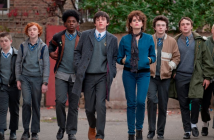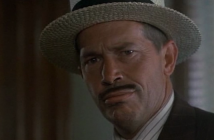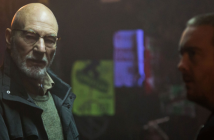
Houses without Doors (dir. Avo Kaprealian, 2016)
The ongoing contemporary global human catastrophe of the refugee crisis is very present and powerful at this year’s Berlin Film Festival. The films that share a common subject matter can be found throughout the programming of the festival including the Official Competition, and the Panorama, Forum and the Generation sections for example, yet all of them can be distinguished by their very different approaches regarding format, style and narrative.
Fuocoammare
Dir. Gianfranco Rosi
Gianfranco Rosi’s entry in the official competition, Fuocoammare is a documentary about the different fates on the remote island of Lampedusa. The small island off the coast of Italy has become a symbol of the devastating refugee crisis with people drowning on a regular basis in the Mediterranean Sea not far from the rough Italian and therefore European coastline – the desired gateway to freedom. Rosi’s documentary depicts the daily life of the people living on Lampedusa. One might assume that the locals are constantly confronted with the tragedies that happen offshore but the protagonist of this film is seemingly living his life without taking notice of what is happening in the waters. Samuele is a 12-year old boy, who wants to become a fisherman just like his father and his grandfather before him. Yet, he gets seasick when he is on the boat with his father and is usually more occupied with his slingshot and his adventures on the land. He seems very disconnected from the water and, despite offering comic relief in many scenes, his behavior of shooting at birds and cactuses with cut out faces is rather questionable. Fuocoammare paints a completely different picture of the island than its “media image” suggests. It shows how distant the crisis seems to the locals who are informed about the drownings through the media just like everyone else in Europe although the disasters happen right in front of their doorsteps. To illustrate these different images of life on and around the island, Rosi alternates from the personally unaffected locals to the rescue teams who try to save drowning people on board of sinking ships – usually overcrowded rubber-boats or small rundown ships filled with dead bodies on the lower levels and dehydrated women, men and children. When the survivors are registered, the camera captures the exhausted, frightened people and their blank stares and adds images to the tragedies that are usually talked about in numbers, especially in when it is newsworthy. Dr. Bartolo, the only doctor on the island, has been at every landing of the refugees and takes care of them in the emergency room. He is the one who decides who is going to get treatment. He, on the contrary to the other people in the documentary, is actually confronted with the tragedies and talks about what he has seen over the years. One of the most touching scenes of Fuocaommare is when Dr. Bartolo talks about his belief that if someone considers themselves a human being, that person has to feel the responsibility to help. With everything he has seen, he can’t imagine to believe anything else.
Houses Without Doors
Dir. Avo Kaprealian
Avo Kaprealian’s documentary Houses Without Doors has been filmed by the director over the course of three years, starting in 2011 and offers an inside look on the civil war in Syria. Kaprealian captures the changes that his neighborhood undergoes in Al Midan, Aleppo’s frontline, secretly filming from his family’s balcony. He zooms in and out of his surroundings while carefully watching his neighbors and the life outside on the streets. In the beginning, the street is filled with people following their daily routine and children playing outside on the streets. However, the daily routine dramatically changes, fewer people spend time outside of their homes, the sounds of gun shots and exploding bombs become the norm and smoke rises above the city in the background while more and more refugees enter the city fleeing from their war-torn homes. At the same time Kaprealian’s neighborhood slowly transforms and more locals emerge to leave Al Midan behind. The documentary is filmed with a handheld camera, therefore the images are often very shaky and out of focus, which adds to the uncomfortable and very voyeuristic feeling that accompanies the documentary. The fact that Kaprealian mostly films from behind closed curtains or other hideouts further encourages the already tense atmosphere and offers an unfiltered look upon the brutal reality of war. Houses without Doors further features clips from feature films and voice overs of oral stories to connect the ongoing war with the Armenian genocide from about a hundred years ago. For Kaprealian and his family, who are of Armenian descendants, history is repeating itself because their forefathers already had to flee torture and persecution once before and found a new home in what is now known to be Syria, a country that is torn apart and offers no perspective anymore. As the family is packing some of their belongings, Kaprealian jokingly comments on being “a modern refugee” because of their suitcases. An innocent joke, yet it illustrates just how much of an ordinary life they lived before the war, a fact that many people in Western countries often forget when they think about refugees. Heartbroken to leave their home behind the family flees to Lebanon, where they find shelter. Yet, the family will never have a “home” anymore which is highlighted by Kaealian’s mother and her nightmares about their former house: the entrance is blocked with rocks and stones which she interprets as never being able to return to Aleppo anymore, because a house without a door cannot be a home anymore.

Life on the Border (2015)
Life on the Border
Dir. Bahman Ghobadi, multiple
Kurdish filmmaker Bahman Ghobadi lends the camera to 8 children living in refugee camps in Kobane and Singal in his film Life on the Border and takes its audience inside these huge camps, where the children are for one finally safe but have no further prospects for their future either while the war is still happening. The documentary focuses on eight individual stories told through the eyes of these children. After a few days of training in cinematography and directing by professionals, the children set out to explore their camps and in order to find a way to cinematically tell their own personal stories – whether it is through the classic form of interviewing their fellow refugees, reenacting scenes or just simply by talking about what they have witnessed, experienced or lost. By using several directors telling their own self-contained stories, Ghobadi creates a mosaic of the traumatic experiences made during the civil war in Syria and the tortue by ISIS, put together by the most vulnerable and innocent.
Les Sauteurs (Those Who Jump)
Dir. Abou Bakar Sidibé, Estephan Wagner, Moritz Siebert
With a general focus on the tragedies of people trying to cross the Mediterranean Sea and a concentrated look upon refugees from Syria, other border crossings and their tragic outcomes are nearly neglected by the media these days. With Les Sauteurs, directors Estephan Wagner and Moritz Siebert shift their focus to the European border on the African mainland. The border between the Spanish enclave of Mellila and nothern Marocco is immensely protected by the authorities and a huge, razor-wired fence system. Yet, many migrants and refugees try to find a way to climb over the fence and risk their lives by doing so in order to reach their final destination: Europe. The protagonist Abou is one of them. He escaped from Mali and lives in a camp on Mount Gurugu in Marocco, a mountain overlooking the fence, the Spanish enclave and with that a possibility of a better life. Sieber and Wagner gave Abou a camera so he can tell his personal story of his live among the other refugees from his own perspective. He has been on Mount Gurugu for 16 months, trying to jump the fence an uncountable number of times and injured himself many times in the process. That does not stop him from trying. Les Sauteurs gives a truthful insight into the harsh conditions at the well-protected European border and the determination of those willing to risk everything they have left in order to escape their old lives. To put a face onto the happenings at the border, Sieber and Wagner mainly use Abou’s intimate and personal images, however, to emphasize the often distant view people have on the ongoing migration to Europe, the filmmakers insert images from surveillance cameras at the fence, contrasting them with the familiar faces the audience has come to know throughout the documentary.



